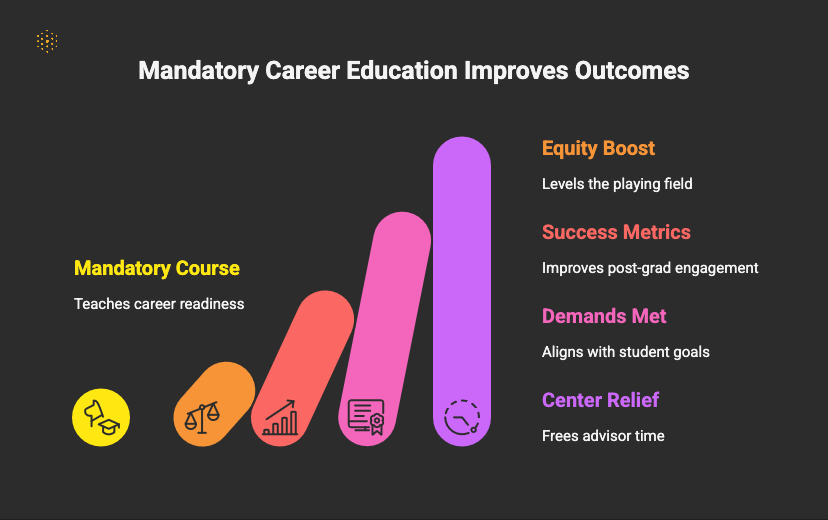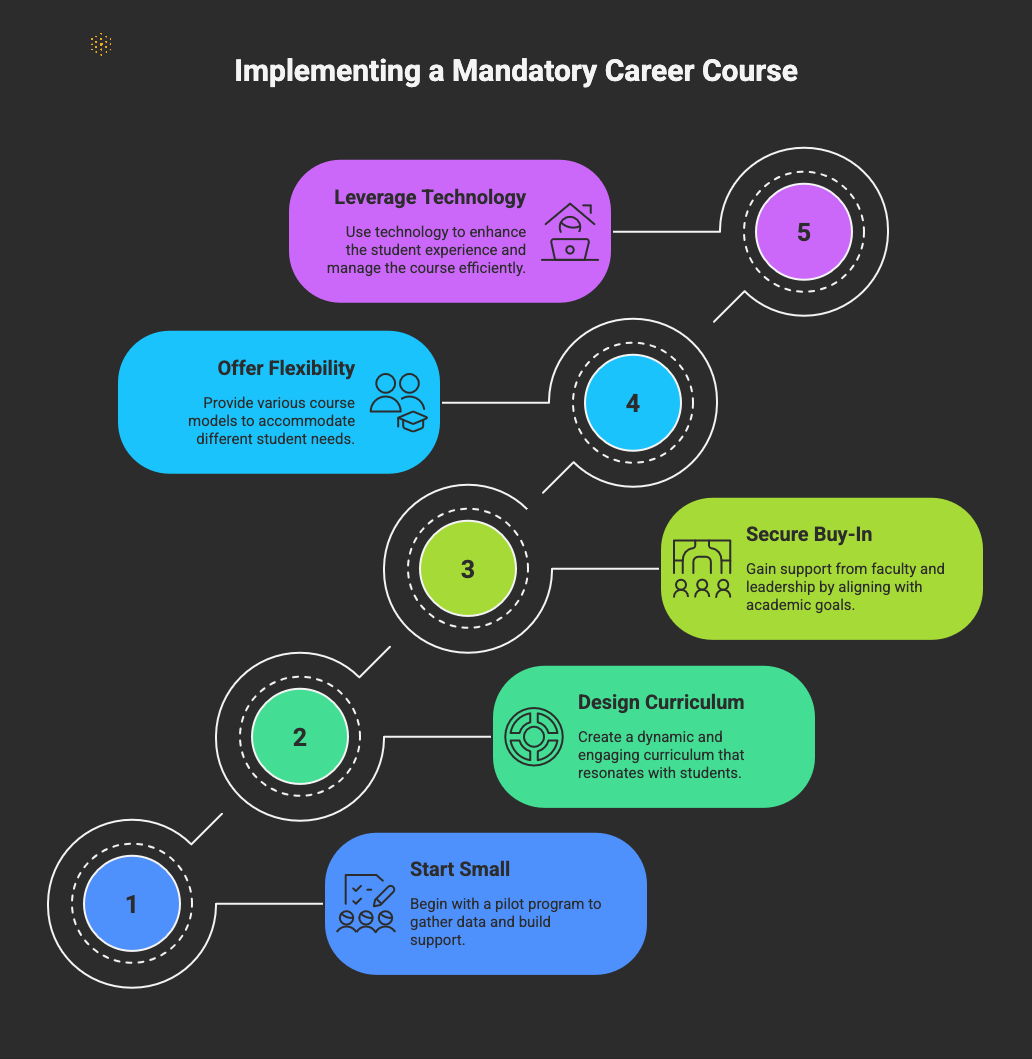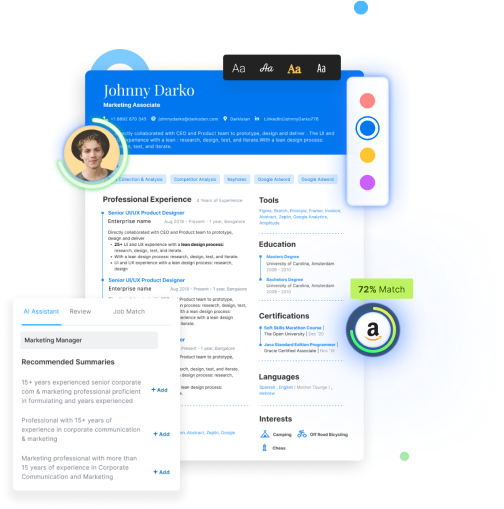Should colleges mandate career courses, and how can they implement them?
Require career courses to close readiness gaps, advance equity, improve outcomes, and scale advising. Start with a pilot and data, design action oriented curriculum, secure faculty buy in, offer flexible models, and use LMS and virtual tools.
Let's be honest. For too long, career services has been an optional, check-the-box activity for many students.
They show up in a panic during their senior year, resume in hand, hoping for a miracle. But the world has changed.
Employers demand more than a degree; they demand skills like communication, critical thinking, and professionalism from day one.
And data shows a worrying number of graduates aren't prepared.
The solution?
Making career development a core part of the academic experience through mandatory career courses. It’s a strategic shift from an opt-in model to a foundational educational requirement.
Here’s why it's a critical move and how you can make it happen.
Why Make Career Education Mandatory?
Making a course mandatory is a big step, but the evidence supporting it is even bigger. It’s about equity, student success, and institutional reputation.
1. The Glaring Career Readiness Gap
There's a massive disconnect between how prepared students think they are and what employers see.
A 2022 study by NACE found that while 79.5% of graduating seniors rated themselves as proficient in professionalism/work ethic, only 42.5% of employers agreed.
This gap exists across all core competencies, from communication to equity and inclusion.
Mandatory courses tackle this head-on by explicitly teaching and assessing these NACE Career Readiness Competencies, ensuring every student has a foundational understanding of employer expectations before they even start their internship search.
Also Read: What are some federal funding options for career centers in the US?
2. It Drives Equitable Outcomes
Optional career services often benefit students who already have the social capital and confidence to seek help.
A report from the Higher Ed Today highlights that first-generation students, students of color, and those from low-income backgrounds are less likely to have networks that can help them navigate their career path.
A required course democratizes access to this crucial knowledge. It ensures that every student, regardless of their background, learns how to write a resume, build a network, interview effectively, and negotiate a salary.
It levels the playing field in a tangible way.
Also Read: How to improve FDS response rates?
3. It Boosts Post-Graduation Success Metrics
The proof is in the numbers. The famous Gallup-Purdue Index found that college graduates were 2.4 times more likely to be engaged at work if they had a professor who cared about them and helped them get excited about learning.
A structured career course, often taught by dedicated career professionals, can create this very environment.
Furthermore, institutions that integrate career development see results. For example, Wake Forest University, with its "College to Career" course series, consistently reports high rates of post-graduation success.
Their model demonstrates that early and consistent career education leads to better employment outcomes and higher starting salaries.
4. It Meets Student and Parent Demand
Students are enrolling in college with their careers in mind. A survey by Ellucian revealed that 56% of high school students cited "getting a good job" as the primary reason for pursuing a degree.
Parents and students are increasingly looking at ROI, and visible, effective career preparation is a powerful selling point for admissions.
A mandatory course is a clear signal that an institution is invested in the long-term success of its students.
Also Read: How is Hiration a better Big Interview alternative?
5. It Alleviates Pressure on Career Centers
With student-to-advisor ratios often stretching into the thousands, it's impossible for career services staff to provide deep, meaningful guidance to every student through one-on-one appointments alone.
A required course is a brilliant scaling strategy. It allows you to deliver foundational knowledge to hundreds of students at once, freeing up advisor time for more specialized and complex coaching.
It moves the department from a purely reactive service model to a proactive educational one.

The "How": A Practical Blueprint for Implementation
Convinced? Great. Now for the practical part. Launching a mandatory course requires strategy, collaboration, and a student-centric approach.
1. Start Small and Build Your Case with Data
You don't need a campus-wide, four-year sequence overnight. Start with a pilot program. Partner with a "friendly" academic department or a first-year experience program.
- Example: Run a one-credit, pass/fail career course for all incoming business or communications majors.
- Action: Before the course, survey students on their career confidence. After the course, survey them again. Track their engagement with your office, their internship application rates, and the quality of their resumes. Use this compelling data to show deans and faculty the tangible impact and build support for expansion.
2. Design a Dynamic, "Un-Boring" Curriculum
Students have a low tolerance for boring, irrelevant requirements. Your course cannot feel like a chore.
- Focus on Action: Don't just lecture about resumes; have them create one and get peer feedback. Don't just talk about networking; require them to conduct an informational interview.
- Bring in a Mix of Voices: Use a blend of career advisors, alumni guest speakers, faculty, and industry recruiters. This keeps the content fresh and provides diverse perspectives.
Also Read: How to help make students great portfolios?
3. Secure Faculty and Leadership Buy-In
This is non-negotiable. Faculty are the gatekeepers of the curriculum. You must frame this as a partnership, not a takeover.
- Speak Their Language: Connect career readiness competencies to academic learning outcomes. Show how communication, critical thinking, and teamwork are already being taught in their classes; the career course simply helps students articulate those skills to employers.
- Present the Data: Show them the NACE data on the readiness gap and your own pilot program results. Emphasize how this improves the value proposition of their degrees.
- Find a Faculty Champion: Identify a well-respected professor who understands the importance of career development. Their advocacy will be more powerful than anything else.
4. Offer Flexible Models
A single, one-size-fits-all course may not work. Be flexible.
- First-Year Experience (FYE) Integration: Build career modules into a required FYE course. This captures students early.
- The One-Credit Model: Offer a standalone, one-credit course required for graduation, which students can take anytime after their first year.
- The Departmental Model: Work with individual academic departments to create a customized career course tailored to their specific industries and student needs.
Also Read: What are some of the best practices for setting up virtual career treks?
5. Leverage Technology to Scale
Use technology to manage the administrative load and enhance the student experience.
- Learning Management System (LMS): Use Canvas, Blackboard, or another LMS to deliver content, collect assignments, and track progress.
- Virtual Tools: Use tools for virtual mock interviews and online networking events to make participation easier for busy students.

Final Thoughts
By making career education a mandatory part of the journey, you're not just adding another requirement.
You're building a culture that prioritizes student success from matriculation to graduation and beyond.
And if you want to equip every student with career‑ready skills while freeing your team to focus on high‑impact guidance, Hiration can help by embedding AI‑powered resume reviews, tailored interview prep, and LinkedIn optimization into your program.
Let’s set up a quick conversation to walk you through how it works.
Frequently Asked Questions
-
What is a mandatory career course?
A mandatory career course is a required academic course that makes career development a core part of the academic experience. You build skills like communication, critical thinking, and professionalism that employers expect from day one.
-
How do mandatory career courses address the career readiness gap?
Through mandatory courses, you explicitly teach and assess NACE Career Readiness Competencies, ensuring every student has a foundational understanding of employer expectations before they even start their internship search.
-
How do mandatory career courses compare to optional career services?
Optional services often benefit students with existing social capital, while a required course you mandate democratizes access. It ensures every student learns to write a resume, build a network, interview effectively, and negotiate a salary.
-
How can you start implementing a mandatory career course?
Start with a pilot program and partner with a friendly academic department or a first-year experience program. Survey students before and after, and track engagement, internship application rates, and resume quality to build support for expansion.
-
How should you design an engaging career curriculum?
Focus on action by having students create a resume with peer feedback and conduct an informational interview. Bring in a mix of career advisors, alumni guest speakers, faculty, and industry recruiters to keep content fresh.
-
How do you secure faculty and leadership buy-in?
Frame it as a partnership and connect career readiness competencies to academic learning outcomes. Present NACE data and pilot results, and identify a well-respected professor as a faculty champion to advocate.
-
What models can you use to require a career course?
Integrate career modules into a required First-Year Experience course, offer a standalone one-credit course required for graduation, or create departmental courses tailored to specific industries and student needs.
-
How can technology help you scale a required course?
Use a learning management system like Canvas or Blackboard to deliver content, collect assignments, and track progress. Use virtual tools for mock interviews and online networking events to make participation easier for busy students.
-
When should students take a required career course?
Capture students early through First-Year Experience integration, or let them take a one-credit course anytime after their first year. Departments can also require customized courses aligned to their specific industries.
-
What mistakes should you avoid when mandating career courses?
Avoid boring, irrelevant requirements that feel like a chore, and skip the one-size-fits-all approach. Do not move forward without faculty partnership and advocacy, because faculty buy-in is non-negotiable.



